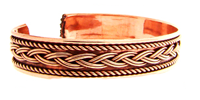 1. Medicinal bracelets offer an attractive, simple, easy-to-use kind of natural medicine. They can also teach us much about deeper patterns of physiology and nutrition.
1. Medicinal bracelets offer an attractive, simple, easy-to-use kind of natural medicine. They can also teach us much about deeper patterns of physiology and nutrition.
2. The bracelets can be composed of various minerals. In practice, to avoid overdosing of trace elements, they tend to contain mainly copper and zinc. The principles governing bracelets also apply to other kinds of jewelry, but here also one needs to steer clear of overdosing. In South Asia silver anklets actually may be implicated in substituting silver for copper in ceruloplasmin, which is essential to iron utilization, thereby contributing to iron-deficiency anemia. A copper-zinc inner side facing the skin could overcome this.
3. In chemical terms, a 90% copper and 10% zinc bracelet works as a passive iontophoresis device wherein the zinc as the sacrificial anode is deposited by the copper cathode onto the skin in an electrochemical reaction that in turn tends to open the skin to absorb the metals (inevitably copper is also deposited and absorbed).
4. In biophysical terms, a copper bracelet creates an electrical field that includes a magnetic component. This source of energy on the wrist appears to stimulate blood cells and affects the energy flow and fields of the body. The effects of the electrochemistry can be enhanced by designing the bracelet as an unbroken ring for stronger copper conductivity, by providing a source of electrical energy, and by adding magnets, which in particular stimulate the red blood cells.
5. Given a state of nutrient deficiency and a source of energy, the bracelets can induce a form of Transdermal Micronutrition (TDM), a primitive response from our distant ancestors who relied entirely on the skin for food intake. The anchoring of the body to a continuous, assured supply of nutrition seems in some cases to trigger a shift from a medusa-like stage to a polyp-like one, with a consequent strong healing response and sense of well-being that cannot be obtained by oral consumption of microminerals.
6. Observers have suggested many explanations of the mechanisms of action of the bracelets, including the skeptics’ view that all effects are imagined or are a placebo response. Given the complexity of the situations in which the bracelets work, including all the vagaries of electrochemistry and the individual’s condition, it seems likely that several effects work together to convey the results, which go well beyond what the skeptics argue. The skeptics typically don’t actually experiment with the bracelets.
7. Indications include localized, minor arthritis, as in the example of an elderly woman with twisted, gnarled fingers who wore a copper-zinc bracelet for 18 days without effect; on the 19th day her pain disappeared and she could wiggle her fingers for the first time in years. Neurological indications deserve investigation: a retired engineer with Essential Tremor wore a copper bracelet with magnets for a week when his wife remarked, “Your hands are not shaking.” He reported that the bracelets reduced his tremor by 80% except when he was under stress, when the effect was only about 33%.
8. Other potentially promising indications include as prophylaxis (by substitution) against environmental toxic substances, as a treatment of depression (with zinc stimulating the production of serotonin), in combatting Hidden Hunger for micronutrients in craving for food and drugs, and (using iron) as a treatment of iron-deficiency anemia, though rust can irritate and stain the skin as well as stain clothing.
9. The bracelets leave green copper on the skin that can be washed away with soap and water. People with contact dermatitis should generally not wear the bracelets. And the bracelets are provisionally counterindicated in Alzheimer’s, though this has never been carefully studied and it is possible that their natural ion-by-ion dosing of copper and zinc can actually prove protective. In general, the bracelets have few side effects.
10. A few clinical trials have shown generally positive effects of the bracelets, and case studies suggest ways of optimizing their effects (e.g., including zinc and designing the bracelet as a complete ring of copper) and various indications. But much more research is needed on this frontier of science.
NOTE: Copper bracelets are counter-indicated for cancer patients because copper can promote metastases.
*****
Kenneth J. Dillon is an historian who writes on science, medicine, and history. See the biosketch at About Us.
